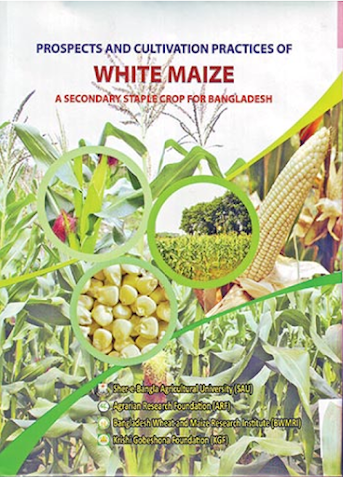Book review in observerbd: PROSPECT AND CULTIVATION PRACTICES OF WHITE MAIZE
https://www.observerbd.com/news.php?id=330574PROSPECT AND CULTIVATION PRACTICES OF WHITE MAIZE:
Dr. Md. Jafar Ullah , Dr Md Ali Akbar and Dr M Abu Zaman SarkerPublished: Saturday, 11 September 2021 at 12:00 AM Count: 681 Reviewed by M Zahidul Haque    | |
 Maize (in British English) which is also known as corn (in American English) is an ancient crop. The indigenous people in Southern Mexico had started cultivation of this cereal grain nearly ten thousand years back. There are a number of maize types such as dent corn, flint corn, sweet corn, etc. The distinction between white maize and yellow maize is in their color of kernels plus some nutritional differences. However, the kernels of white corn are sweet and soft; flour produced from white maize is white and much liked by consumers. Maize (Zea mays L.) is one of the world's major cereal crops. In the introductory section of the book, the importance of maize has been described. Although maize is mainly traded as a feed crop it is also consumed as a food crop too. With the rising of global population, shrinking of arable lands due to industrialization, and climate change impacts, the production and use of maize merits as a staple food crop. In the context of Bangladesh, maize can effectively help in maintaining food self-sufficiency plus food security. As mentioned in the book, investigators involved in the project conducted in-depth research on various aspects of maize in different parts of Bangladesh. In total, 49 genotypes collected from home and abroad were tested in different research stations and farmer's fields along with generating production technologies. Maize contains many vitamins and essential minerals plus fiber. White maize flour could be a very nutritious staple food for the people of Bangladesh. Hence in the conclusion section, emphasis has been given on the extension of maize cultivation by motivating farmers. The incorporation of a number of clear images visualizing different steps in maize production has made the book more attractive and useful. In fact, the book is a practical guide for those who might undertake maize research and development in the future. The book has been creditably edited by Prof. Dr. Jamilur Rahman of SAU and published by the Department of Agronomy, Sher-e-Bangla Agricultural University, Dhaka The reviewer is a Professor, at the Department of Agricultural Extension & Information Systems, Sher-e-Bangla Agricultural University, Dhaka |









No comments